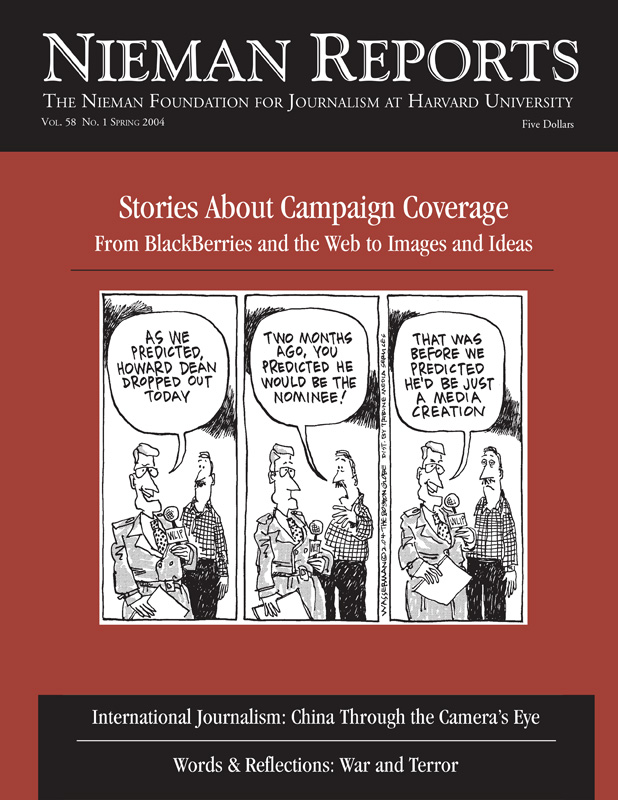 Backstory: Inside the Business of News
Backstory: Inside the Business of News
Ken Auletta
The Penguin Press. 296 Pages. $24.95.
No reporter, in my opinion, has a better understanding of the business of news than Ken Auletta, The New Yorker’s media critic and analyst. Over the years, in careful probes into the boardrooms and executive suites of U.S. media companies, he has made his readers eyewitnesses to crucial decisions affecting print and electronic media as well as digital communication. To do this he has painstakingly earned exceptional access and remarkable rapport with all sorts of media owners and executives without ever forgetting that he is first and foremost a journalist. Indeed, even in the face of his own celebrity, the lure of television and the speaking circuit, Auletta’s work has deepened and matured. No matter what, he is always the thoroughgoing investigator, offering multiple sources and detailed assessment, when other media critics take shortcuts.
His latest offering, “Backstory: Inside the Business of News,” published in 2003 by The Penguin Press, does not disappoint. While “Backstory” is largely a collection of published articles from The New Yorker with updated postscripts, they warrant reconsideration individually and as a purposeful look at the writer’s capacity to chart change, whether radical or incremental, in the media and entertainment industries.
Still, there is a wistful tone in Auletta’s romance with journalism set against business realities in this caveat:
“As a reporter, I’ve learned it’s the nature of corporate executives to extol the virtues of synergy, profit margins, the stock price, cost cutting, extending the brand, demographics, ratings and getting on the team. Journalists rarely share these concerns, so we often denounce what we see as dumb corporate decisions that do violence to journalism. We would do better to recognize that this is the nature of the business culture and figure out how to translate our journalistic concerns into language corporate executives can understand. Since they write the checks, somehow journalists must persuade our corporate chiefs to broaden their too narrow definition of success.”
Unfortunately, Auletta makes this plea at a time when journalism (the news and information function of the media) has clearly been demoted, when journalistic competence is rarely the route to top leadership in the corporation, and when technology and formats often triumph over substance and content. Since many universal values and certitudes that journalists hold dear were fashioned in an era when newspaper companies (and their subsequent corporate owners) were led by executives who emerged from the newsroom, it is not surprising that those assumptions are no longer embedded in the minds and hearts of their successors who are increasingly drawn from the business side—and even from other industries. Any assessment of corporate and journalistic values must begin with some semblance of mutual understanding and recognition that few media companies are now led by former news executives.
Persuading owners and executives in commercial enterprises that they should find broader measures for success that go beyond the profit motive seems a hard sell, and it begs the question of whether journalists as advocates for their own interests, which they believe to be the public interest, are sufficiently impartial as witnesses of change in the media industries.
Nonetheless, “Backstory” offers rich detail on the rise, operational style, and eventual demise of Howell Raines, the brilliant and ultimately dethroned executive editor of The New York Times. The book opens with a 62-page explication of the “Howell Doctrine,” which accurately captures the editor’s creative flair, deeply held values, and missteps as a manager and leader. Another lengthy chapter takes us back to the early days of Publisher Arthur Sulzberger, Jr.’s reign and sets the stage for ultimately understanding the underlying rationale for his less-than-adroit handling of the Jayson Blair fiasco a decade later.
Both pieces are worthy entreaties reminding us of the “gold standard” value of The New York Times, but also serve as case studies of mangled management when good intentions had unintentioned consequences. Sometimes forgotten is the fact that this undisputedly great newspaper might be the model for the beneficent owner, but has rarely been an early initiator of change in journalism, whether in developing special sections, welcoming lively writing, introducing color and vivid graphics, or other innovations that typically happen elsewhere first, then are later (and often grudgingly) adopted by the Times.
Juxtaposed with the good values of The New York Times—and I do believe they are—we are reintroduced in freeze-frame, circa 1997, to Times Mirror’s Mark Willes, a gifted packaged foods executive, but hapless in his efforts to meld business and journalistic values at the Los Angeles Times. Willes’s seemingly radical and widely publicized efforts to break down the walls between editorial and advertising functions and Auletta’s reminder of the celebrated Staples Center incident might seem dated now, but offer a cautionary tale for executives who fail to understand the power journalists wield when insisting on the primacy of journalistic values and ethics. It is naive, though, to think that there are not coexisting ethical values among business professionals and journalists. Sometimes their values do conflict, but because there are few absolutes, compromises can occur. And in all instances, it’s not a matter of moralistic right and wrong.
While Auletta has written extensively about synergies and convergences, that topic is only gently explored here in a piece called “Synergy City,” which surveys the highly successful strategies and outcomes of the Tribune Co. and its integration of content and technologies between and among publishing, broadcasting and Internet investments. Auletta argues that the flagship Chicago Tribune is better than it once was (even a decade ago), but not as good as it could be. This assessment is based on extensive interviews and a careful reading of the Chicago Tribune and three other newspapers that fly the Tribune flag. What emerges is the best business case study I’ve seen on the balance between journalistic integrity and profitability. Auletta rightly sizes up the quiet confidence of the Tribune Co., juxtaposed against the more transparent and less effective efforts of Times Mirror and Mark Willes, who became a symbol of corporate values run amok. Parenthetically, Tribune Co. later acquired Times Mirror.
There is time for journalism’s idiosyncrasies in Auletta’s journey as well with a superb and previously unpublished study of the tabloid wars in New York City and pieces on radio shock jock Don Imus and Fox News. As always, the people behind the paper or the box (Imus or Fox’s Roger Ailes) get thoroughgoing scrutiny. If other critics are wont to give these two a pass as media eccentrics, Auletta is not and measures them up against their claims. Imus emerges as an amusing (or maddening) curmudgeon while Ailes and the content he has wrought (including Bill O’Reilly) fail on the journalism metric even while being acknowledged as successful in the counting house. Other pieces in the book include Auletta’s well-known critique of undisclosed speaking fees by journalistic celebrities and a thoughtful reflection on presidential campaign coverage, albeit circa 1996.
Journalists’ Reluctance to Change
While Ken Auletta is as good as media reporters/critics get, there are times when I wish his passionate defense of journalistic certitudes and moral imperatives made him more empathetic with industry innovators and visionaries who cross swords with the status quo. As Auletta knows as well as anyone, the reportorial culture is rarely innovative or open to structural or stylistic change since change often is perceived as a devaluation of journalistic values. Ironically, he expresses admiration for such stylistic pioneers as Gay Talese and Lillian Ross and other New Journalists of the 1960’s and 1970’s. I say this is ironic because during that period, in a study of New Journalism, I interviewed many top editors whom Auletta would also presumably admire, and most decried the innovations of New Journalism that are now commonplace. It turns out that people interested in readership, ratings and compelling coverage were more likely to recognize this as a worthwhile and progressive change than were the grumpy denizens of the newsroom who believed these and other writers were defiling the journalistic temple. By the same token, Auletta doubts that many of the experiments today with synergy and convergence might ultimately have value.
It is certainly true that journalists are sometimes shortsighted and business side people are sometimes more willing to take risks—even if sometimes they turn out badly. In recent interviews at the 25 top U.S. media companies, corporate executives frequently asserted that journalistic skills are rarely useful for people developing digital strategies for journalistic content. The possible reason is that journalists have a harder time seeing the forest from their perch in the branches of the trees. And to some media executives it seems that journalistic competencies and perspectives can run counter to what is needed for clear strategic thinking, which requires an openness to new formats and forms in the midst of changing styles and standards of journalism. It is wise to remember that every major change in journalism, from the invention of the copy desk to the new technologies of the Internet, was fiercely resisted before it was eventually accepted and integrated.
In an era when ever-larger media companies are being created, are journalists—many of whom have vested interests in retaining the status quo—able to offer reliable assessments about the impact of this change? Perhaps it was always this way, but it seems today that journalists, who feel increasingly dissatisfied with their role in the corporation, are hardly in a position to offer impartial analysis of the changes they are experiencing.
Sorting out the role of the individual journalist in the midst of these seismic changes in the structure and ownership of the business warrants deep thinking, and Auletta facilitates that process. When journalists ask media executives to be more flexible and open-minded, it is not such a stretch that they will ask the same of journalists, in return. That need not be a Faustian bargain, though that possibility exists. A comprehensive journey through the history of journalism shows, on balance, progress and improvement. The truth is that journalists lack a pervasive theory and accept change slowly while business-side managers can move more strategically and swiftly. We should remember that neither is right all of the time and that the clash of values can sometimes be beneficial. But reconciling differences is more than a matter of journalists persuading owners that their short-term, profit-oriented thinking is wrong. Journalists think in short cycles too, though for different reasons. That is why Auletta’s take on the business of news is so important—and must engage the interest of others who aren’t in this business if the public is truly to be well served. Fortunately, Auletta demonstrates persuasively why the bargaining game between journalism and business is more than “inside baseball” and warrants continued public attention—and citizen engagement.
Everette E. Dennis is Distinguished Felix E. Larkin professor of media and entertainment industries at Fordham’s Graduate School of Business in New York and the author of many books and articles about journalism and media industries ranging from the New Journalism to convergence and digital strategies.



